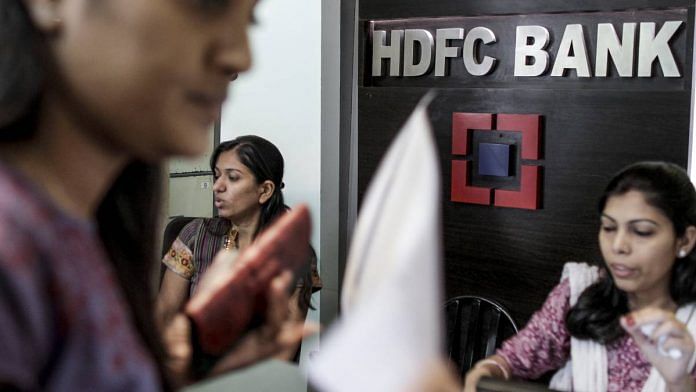Mumbai: On 2 December, the Reserve Bank of India (RBI) asked HDFC Bank, the largest private sector lender in the country, to halt all launches of its digital business generating activities under its programme Digital 2.0 and also asked the bank to stop issuing credit cards to new customers.
At 14.97 million, HDFC Bank is the market leader in terms of number of credit cards issued.
The decision of the banking regulator comes after several incidents of outages in internet banking, mobile banking and payment systems over the past two years, including recent outages in the bank’s internet banking and payment system on 21 November 2020 due to a power failure in the primary data centre.
“The above measures shall be considered for lifting upon satisfactory compliance with the major critical observations as identified by the RBI,” HDFC Bank said in a statement filed with the exchanges Thursday morning.
“We will work with the experts and the regulator to fortify the identified areas for improvement. Internally, we are looking at this as an opportunity to further improve ourselves and emerge stronger,” said Sashi Jagdishan, MD and CEO of HDFC Bank, in a statement released to media Thursday afternoon.
A year ago, on 5 December 2019, following customer complaints of outage, RBI deputy governor M.K. Jain had said that a team from the central bank had gone to HDFC Bank to identify the reasons behind the crash in the bank’s online facilities.
Also read: HDFC’s continuing digital glitch keeps customers locked out, and even some business
Why the frequent outages
Most of such incidents of outage occurred during the first few days of the month. Volumes of transactions are typically higher during these days — salaries are credited, digital cash transfers are made, equated monthly instalments are debited and so on. According to bank insiders, the existing IT infrastructure was unable to cope up with the ever-increasing volumes.
Jagdishan, who took charge in October, said the bank had two outages, one in November 2018 and a second in December 2019.
“We have taken help of external expertise, understood what needs to be done further and have substantially implemented the inputs to strengthen our IT infrastructure and systems. Unexpectedly another incident happened on Nov 21,2020 and the primary reason for the same is the power outage in our Primary Data Centre. We are working on war footing to strengthen this area also now,” he said in the statement.
HDFC Bank is one of the few banks which has consistently grown over the last decade. The economic slowdown and the bad loan problem which impacted business growth of most other banks did not have any significant impact on the bank’s business expansion.
“A pipe was designed to handle a particular volume. But the volumes have gone up substantially while the capacity of the pipe has remained the same. It is not easy to replace the entire pipe,” said a HDFC Bank insider while explaining the reason behind the frequent outages and the bank’s inability to address the issue quickly.
In 2018, the bank launched an upgraded mobile banking application. The outage issue started to occur in 2019 when many customers were not able to log in, and later the internet banking platform was also impacted.
Also read: What crisis? HDFC Bank is ramping up corporate loans while rivals are retreating
High digital banking volume
Most HDFC Bank customers prefer to bank digitally. Digital transactions were 95.1 per cent of the total retail transactions as of March 2020, up from 85.1 per cent from March 2018. The bank has over 5.6 crore customers. The only other bank which is bigger than HDFC Bank is the State Bank of India (SBI), but the number of customers who prefer digital banking in HDFC Bank is much higher than any other bank.
HDFC Bank launched its new public website in 2019 and clocked in an average 55 million visitors per month. The number of customer queries handled by its AI assistant EVA (extended visual assistant) grew to 23 lakh per month, according to the bank’s annual report of 2019.
Then, the bank drew up a plan for Digital 2.0 — the next phase of its digital journey, which the RBI has now asked the lender to suspend.
Ramesh Lakshminarayanan had been appointed new chief information officer in November 2020 to spearhead the bank’s digital transformation.
Also read: Why this one analyst has been pessimistic about investing in HDFC Bank despite its profits
Largest credit card customer base
On credit cards, HDFC Bank is by far the market leader, leading the second largest player — SBI Cards — by four million. The credit card business of the bank saw steady growth, and the lender had set a target of 25 million customers.
HDFC Bank said they have been taking conscious, concrete steps to remedy the recent outages on its digital banking channels and has assured customers that RBI’s actions will have no impact on its existing credit cards, digital banking channels and operations.
“The Bank believes that these measures will not materially impact its overall business,” said the statement filed with the exchanges.
“The Bank over the last two years has taken several measures to fortify its IT systems and will continue to work swiftly to close out the balance and would continue to engage with the Regulator in this regard,” it added.
In his statement, Jagdishan sought to assure customers and said the bank will comply with the regulator’s requirements.
“We take this opportunity to assure our existing customers that there is no reason to worry. You can continue to transact with the Bank without any concern,” he said.
Also read: HDFC Bank probed ‘improper lending, conflict of interest’ in its vehicle loans unit







have a nice day